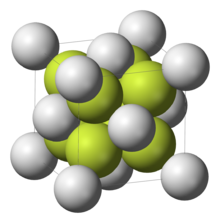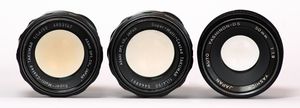ثاني أكسيد الثوريوم

| |
| الأسماء | |
|---|---|
| اسم أيوپاكs
Thorium dioxide
Thorium(IV) oxide | |
| أسماء أخرى
Thoria
Thorium anhydride | |
| المُعرِّفات | |
| رقم CAS | |
3D model (JSmol)
|
|
| ECHA InfoCard | 100.013.842 |
PubChem CID
|
|
CompTox Dashboard (EPA)
|
|
| الخصائص | |
| الصيغة الجزيئية | ThO2 |
| كتلة مولية | 264.04 g/mol |
| المظهر | white solid |
| الرائحة | odorless |
| الكثافة | 10.00 g/cm3 |
| نقطة الانصهار | |
| نقطة الغليان | |
| قابلية الذوبان في الماء | insoluble |
| قابلية الذوبان | insoluble in alkali slightly soluble in acid |
| القابلية المغناطيسية | −16.0·10−6 cm3/mol |
| معامل الانكسار (nD) | 2.200 (thorianite) |
| البنية | |
| البنية البلورية | Fluorite (cubic), cF12 |
| الزمرة الفراغية | Fm3m, No. 225 |
| ثابت العقد | a = 559.74(6) pm[1] |
| هندسة إحداثية |
Tetrahedral (O2−); cubic (ThIV) |
| الكيمياء الحرارية | |
| الإنتالپية المعيارية للتشكل ΔfH |
−1226(4) kJ/mol |
| Standard molar entropy S |
65.2(2) J K−1 mol−1 |
| المخاطر | |
| NFPA 704 (معيـَّن النار) | |
| نقطة الوميض | Non-flammable |
| الجرعة أو التركيز القاتل (LD, LC): | |
LD50 (الجرعة الوسطى)
|
400 mg/kg |
| مركبات ذا علاقة | |
كاتيونات أخرى
|
Hafnium(IV) oxide Cerium(IV) oxide |
مركـّبات ذات علاقة
|
Protactinium(IV) oxide Uranium(IV) oxide |
ما لم يُذكر غير ذلك، البيانات المعطاة للمواد في حالاتهم العيارية (عند 25 °س [77 °ف]، 100 kPa). | |
| مراجع الجدول | |
Thorium dioxide (ThO2), also called thorium(IV) oxide, is a crystalline solid, often white or yellow in color. Also known as thoria, it is produced mainly as a by-product of lanthanide and uranium production.[1] Thorianite is the name of the mineralogical form of thorium dioxide. It is moderately rare and crystallizes in an isometric system. The melting point of thorium oxide is 3300 °C – the highest of all known oxides. Only a few elements (including tungsten and carbon) and a few compounds (including tantalum carbide) have higher melting points.[2] All thorium compounds are radioactive because there are no stable isotopes of thorium.
Structure and reactions
Thoria exists as two polymorphs. One has a fluorite crystal structure. This is uncommon among binary dioxides (others with fluorite structure include cerium dioxide, uranium dioxide and plutonium dioxide).[مطلوب توضيح] The band gap of thoria is about 6 eV. A tetragonal form of thoria is also known.
Thorium dioxide is more stable than thorium monoxide (ThO).[3] Only with careful control of reaction conditions can oxidation of thorium metal give the monoxide rather than the dioxide. At extremely high temperatures, the dioxide can convert to the monoxide either by a disproportionation reaction (equilibrium with liquid thorium metal) above 1,850 K (1,580 °C; 2,870 °F) or by simple dissociation (evolution of oxygen) above 2,500 K (2,230 °C; 4,040 °F).[4]
Applications
Nuclear fuels
Thorium dioxide (thoria) can be used in nuclear reactors as ceramic fuel pellets, typically contained in nuclear fuel rods clad with zirconium alloys. Thorium is not fissile (but is "fertile", breeding fissile uranium-233 under neutron bombardment); hence, it must be used as a nuclear reactor fuel in conjunction with fissile isotopes of either uranium or plutonium. This can be achieved by blending thorium with uranium or plutonium, or using it in its pure form in conjunction with separate fuel rods containing uranium or plutonium. Thorium dioxide offers advantages over conventional uranium dioxide fuel pellets, because of its higher thermal conductivity (lower operating temperature), considerably higher melting point, and chemical stability (does not oxidize in the presence of water/oxygen, unlike uranium dioxide).
Thorium dioxide can be turned into a nuclear fuel by breeding it into uranium-233 (see below and refer to the article on thorium for more information on this). The high thermal stability of thorium dioxide allows applications in flame spraying and high-temperature ceramics.
السبائك
Thorium dioxide is used as a stabilizer in tungsten electrodes in TIG welding, electron tubes, and aircraft engines. As an alloy, thoriated tungsten metal is not easily deformed because the high-fusion material thoria augments the high-temperature mechanical properties, and thorium helps stimulate the emission of electrons (thermions). It is the most popular oxide additive because of its low cost, but is being phased out in favor of non-radioactive elements such as cerium, lanthanum and zirconium.
Thoria dispersed nickel finds its applications in various high temperature operations like combustion engines because it is a good creep resistant material. It can also be used for hydrogen trapping.[5][6]
Catalysis
Thorium dioxide has almost no value as a commercial catalyst, but such applications have been well investigated. It is a catalyst in the Ruzicka large ring synthesis. Other applications that have been explored include petroleum cracking, conversion of ammonia to nitric acid and preparation of sulfuric acid.[7]
Radiocontrast agents
Thorium dioxide was the primary ingredient in Thorotrast, a once-common radiocontrast agent used for cerebral angiography, however, it causes a rare form of cancer (hepatic angiosarcoma) many years after administration.[8] This use was replaced with injectable iodine or ingestable barium sulfate suspension as standard X-ray contrast agents.
Lamp mantles
Another major use in the past was in gas mantle of lanterns developed by Carl Auer von Welsbach in 1890, which are composed of 99 percent ThO2 and 1% cerium(IV) oxide. Even as late as the 1980s it was estimated that about half of all ThO2 produced (several hundred tonnes per year) was used for this purpose.[9] Some mantles still use thorium, but yttrium oxide (or sometimes zirconium oxide) is used increasingly as a replacement.
Glass manufacture
When added to glass, thorium dioxide helps increase its refractive index and decrease dispersion. Such glass finds application in high-quality lenses for cameras and scientific instruments.[10] The radiation from these lenses can darken them and turn them yellow over a period of years and degrade film, but the health risks are minimal.[11] Yellowed lenses may be restored to their original colourless state by lengthy exposure to intense ultraviolet radiation. Thorium dioxide has since been replaced by rare-earth oxides such as lanthanum oxide in almost all modern high-index glasses, as they provide similar effects and are not radioactive.[12]
المراجع
- ^ أ ب Yamashita, Toshiyuki; Nitani, Noriko; Tsuji, Toshihide; Inagaki, Hironitsu (1997). "Thermal expansions of NpO2 and some other actinide dioxides". J. Nucl. Mater. 245 (1): 72–78. doi:10.1016/S0022-3115(96)00750-7.
{{cite journal}}: CS1 maint: postscript (link) - ^ Emsley, John (2001). Nature's Building Blocks (Hardcover, First ed.). Oxford University Press. p. 441. ISBN 0-19-850340-7.
- ^ He, Heming; Majewski, Jaroslaw; Allred, David D.; Wang, Peng; Wen, Xiaodong; Rector, Kirk D. (2017). "Formation of solid thorium monoxide at near-ambient conditions as observed by neutron reflectometry and interpreted by screened hybrid functional calculations". Journal of Nuclear Materials. 487: 288–296. doi:10.1016/j.jnucmat.2016.12.046.
- ^ Hoch, Michael; Johnston, Herrick L. (1954). "The Reaction Occurring on Thoriated Cathodes". J. Am. Chem. Soc. 76 (19): 4833–4835. doi:10.1021/ja01648a018.
- ^ Mitchell, Brian S (2004). An Introduction to Materials Engineering. and Science for Chemical and Materials. p. 473. ISBN 978-0-471-43623-2.
- ^ Robertson, Wayne M. (1979). "Measurement and evaluation of hydrogen trapping in thoria dispersed nickel". Metallurgical and Materials Transactions A. 10 (4): 489–501. doi:10.1007/BF02697077.
{{cite journal}}: CS1 maint: postscript (link) - ^ Wolfgang Stoll "Thorium and Thorium Compounds" Ullmann's Encyclopedia of Industrial Chemistry 2012 Wiley-VCH, Weinheim. doi:10.1002/14356007.a27_001
- ^ https://radiopaedia.org/articles/thorotrast
- ^ Greenwood, Norman N.; Earnshaw, Alan (1984). Chemistry of the Elements. Oxford: Pergamon Press. pp. 1425, 1456. ISBN 978-0-08-022057-4.
- ^ Hammond, C. R. (2004). The Elements, in Handbook of Chemistry and Physics (81st ed.). CRC Press. ISBN 978-0-8493-0485-9.
- ^ Oak Ridge Associated Universities (1999). "Thoriated Camera Lens (ca. 1970s)". Retrieved 29 September 2017.
- ^ Stoll, W. (2005). "Thorium and Thorium Compounds". Ullmann's Encyclopedia of Industrial Chemistry. Wiley-VCH. p. 32. doi:10.1002/14356007.a27_001. ISBN 978-3-527-31097-5.
- CS1 maint: postscript
- ECHA InfoCard ID from Wikidata
- Articles containing unverified chemical infoboxes
- Short description is different from Wikidata
- جميع الصفحات التي تحتاج تنظيف
- مقالات بالمعرفة تحتاج توضيح from August 2018
- Articles with hatnote templates targeting a nonexistent page
- ذيفانات الكبد
- أكاسيد
- مركبات الثوريوم
- مواد حرارية

